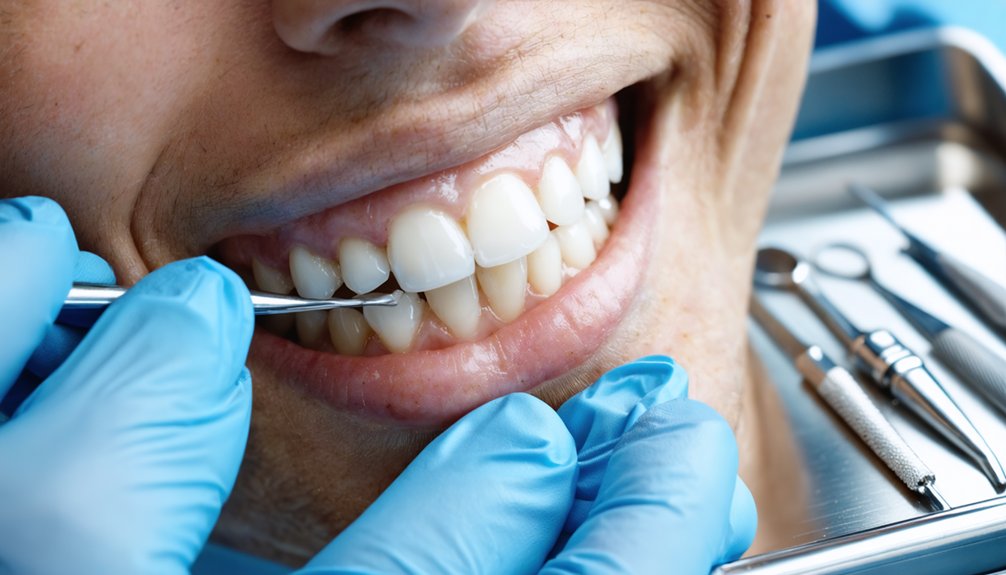To tackle stubborn teeth discoloration effectively, you’ll need a multi-faceted approach combining professional treatments with at-home care. Start with a dental assessment to identify whether your stains are extrinsic or intrinsic, as this determines the ideal treatment path. For resistant stains, consider advanced options like deep bleaching systems or LED-activated treatments with high-concentration peroxide gels. Pair professional interventions with proper maintenance techniques to achieve lasting results, as successful whitening requires both immediate and long-term strategies.
Key Takeaways
- Professional deep bleaching systems like KöR specifically target resistant intrinsic stains from tetracycline, fluorosis, and dental trauma.
- Combine in-office LED or laser treatments with high-concentration peroxide gels (25-35%) for maximum effectiveness on stubborn stains.
- Use custom-fitted trays with prescription-strength whitening gels for consistent, long-term treatment of difficult discoloration.
- Start desensitizing treatments with potassium nitrate or fluoride products two weeks before whitening to minimize sensitivity.
- Schedule regular professional follow-up care every 6-12 months and maintain daily preventive measures to preserve whitening results.
Understanding Different Types of Tooth Stains
When it comes to dental staining, understanding the location and type of discoloration is essential for effective treatment.
You’ll encounter three primary classifications of tooth stains: extrinsic, intrinsic, and internalized.
Extrinsic stains affect the outer enamel surface and typically result from lifestyle factors like coffee, tea, wine consumption, or smoking. You can often address these through professional cleaning or over-the-counter whitening products. These surface stains are more easily treated than other types.
In contrast, intrinsic stains develop within the tooth structure, particularly in the dentin, and stem from causes such as childhood medication exposure, dental trauma, or excessive fluoride intake. These deeper stains usually require more intensive professional interventions.
As you age, you may experience a combination of both types, as enamel naturally thins and dentin darkens, creating complex discoloration patterns that need thorough treatment approaches. Maintaining good oral hygiene through regular brushing and flossing can help prevent or minimize the development of these stains.
Professional Whitening Methods Explained
Professional teeth whitening methods incorporate advanced light-based treatments like laser and LED systems that activate high-concentration peroxide gels for rapid results.
You’ll find that in-office peroxide applications, administered under careful dental supervision, can achieve up to eight shades of whitening in a single visit. With proper maintenance and care, these dramatic results can last 1-3 years.
Your dentist may also provide professional-grade at-home systems with custom-fitted trays and specialized gels for maintenance between office visits or as a standalone treatment option. Advanced diagnostic tools assess treatment suitability by examining factors like enamel thickness and gum health before proceeding with any whitening procedure.
Advanced Light Treatment Options
Light-based teeth whitening treatments have revolutionized professional dental aesthetics through advanced technology and improved safety protocols.
Today’s laser innovations combine high-precision delivery systems with specialized bleaching agents, offering you dramatic results in just one hour. You’ll find that modern LED advancements provide a cooler, gentler alternative that’s equally effective for most patients. A protective gum barrier is carefully applied before treatment begins.
When you’re considering light-based treatments, you’ll have access to customizable options that match your sensitivity levels and whitening goals. These professional treatments can lighten your teeth by up to eight shades.
Professional treatments utilize higher peroxide concentrations (25-35%) than at-home kits, delivering faster, more sustainable results. While you might experience temporary sensitivity, especially with laser treatments, your dentist can adjust the protocol to guarantee peak comfort.
Both laser and LED systems can be complemented with take-home maintenance trays to extend your whitening results.
In-Office Peroxide Applications
While advanced light treatments offer innovative whitening solutions, in-office peroxide applications remain the cornerstone of professional teeth whitening. Your dentist will carefully prepare your teeth and protect your gums using specialized barriers before applying high-concentration peroxide gel. The American Dental Association recommends professional supervision for these higher concentration whitening treatments.
During your treatment, you’ll experience these essential steps:
- Professional cleaning and complete drying of teeth surfaces to guarantee ideal gel application.
- Application of protective barriers to shield your gums from the 35-44% hydrogen peroxide gel.
- Precise gel placement using dual-barrel syringes for maximum potency and effectiveness.
- Multiple 15-20 minute supervised sessions with careful monitoring of results.
The professional-grade hydrogen peroxide works by releasing reactive oxygen radicals that break down stubborn stain molecules embedded in your enamel. Safety measures are paramount throughout the procedure, and you’ll receive specific post-treatment care instructions to maintain your results and manage any temporary sensitivity.
At-Home Professional Systems
When seeking professional-grade teeth whitening from home, dentist-prescribed systems offer a compelling balance of effectiveness and convenience.
You’ll receive prescription-strength peroxide formulations that deliver noticeable improvements within days, often lasting months with proper maintenance. These systems typically include custom trays that guarantee precise gel application while minimizing gum exposure. Deep intrinsic stains require professional dental supervision for optimal whitening outcomes. Opting for professional take-home kits over store options provides higher peroxide concentrations for faster whitening.
Your dentist will evaluate your oral health before prescribing a system that may include sensitivity reduction features like potassium nitrate and fluoride.
You’ll follow a specific protocol, wearing the trays for prescribed durations—either short daily sessions or overnight treatments. While temporary tooth sensitivity may occur, custom-fitted trays and specialized formulations help minimize discomfort.
For enhanced results, you can combine at-home treatments with in-office procedures under your dentist’s supervision.
At-Home Vs In-Office Treatment Options
Choosing between at-home and professional teeth whitening treatments involves weighing several key factors, including effectiveness, cost, and safety.
While at-home options offer convenience and lower initial costs, professional treatments provide superior whitening effectiveness and treatment safety under expert supervision.
Professional teeth whitening maximizes both safety and results through expert oversight, despite the appeal of cheaper, convenient at-home alternatives.
Consider these key differences when making your decision:
- Professional treatments deliver immediate, dramatic results that last 1-3 years, while at-home methods require longer treatment times for modest improvements.
- In-office procedures use higher-strength bleaching agents safely under dental supervision, minimizing risks of sensitivity and gum irritation.
- At-home kits cost less initially but may require repeated purchases for maintenance.
- Professional treatments offer customized solutions and consistent results across all teeth, with included follow-up care and expert guidance.
Managing Sensitivity During Whitening
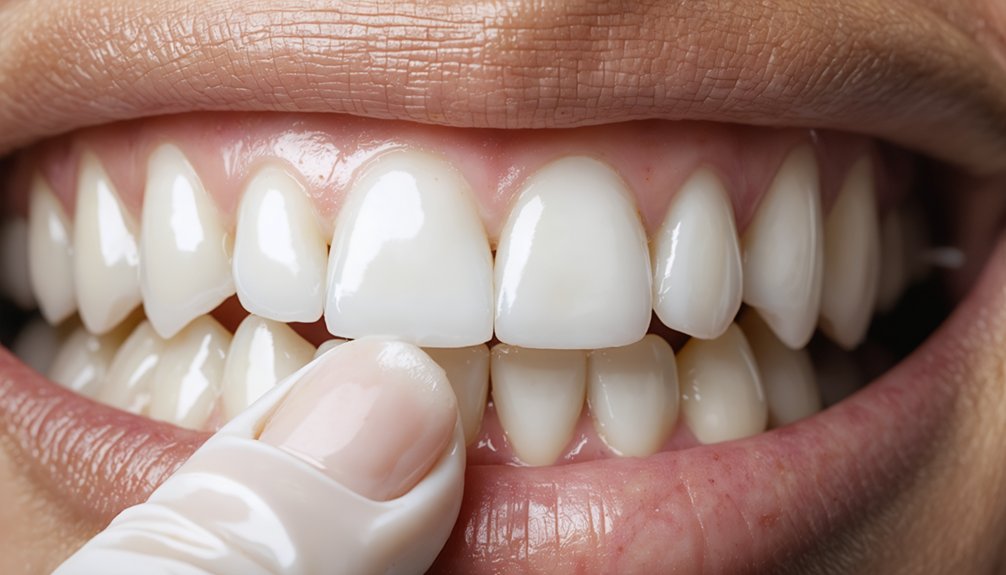
Although teeth whitening can effectively brighten your smile, the process often triggers temporary sensitivity in many patients. You’ll find several sensitivity solutions to help manage discomfort during treatment.
Start using desensitizing products containing potassium nitrate or fluoride 1-2 weeks before whitening to pre-condition your teeth. During treatment, reduce application time if sensitivity occurs, and use custom-fitted trays to minimize gum contact.
Post-whitening care is essential. Avoid hot and cold foods for 48 hours, and drink through a straw to limit beverage exposure to sensitive teeth.
Choose calcium-rich foods like yogurt to strengthen enamel, while avoiding acidic and sugary items. Brush gently with soft bristles and continue using desensitizing toothpaste.
For best results, maintain regular dental supervision to adjust treatment protocols based on your sensitivity levels.
Deep Bleaching Solutions for Resistant Stains
For patients with resistant tooth discoloration, deep bleaching solutions offer powerful treatment options that penetrate beyond surface stains.
When you’re dealing with intrinsic stains from tetracycline, fluorosis, or trauma, traditional whitening methods often fall short. Deep bleaching techniques provide specialized solutions for these challenging cases.
Here’s what you’ll find most effective for treating resistant stains:
- KöR Deep Bleaching System, which uses proprietary gels to reach deep within the enamel
- Internal bleaching procedures for addressing discoloration from root canals
- Professional in-office treatments combining high-concentration gels with LED activation
- Custom-fitted trays for at-home maintenance with specialized whitening agents
For best results, you’ll want to combine these approaches under professional supervision, particularly when treating severe cases of intrinsic staining.
Maintaining Your Whitening Results
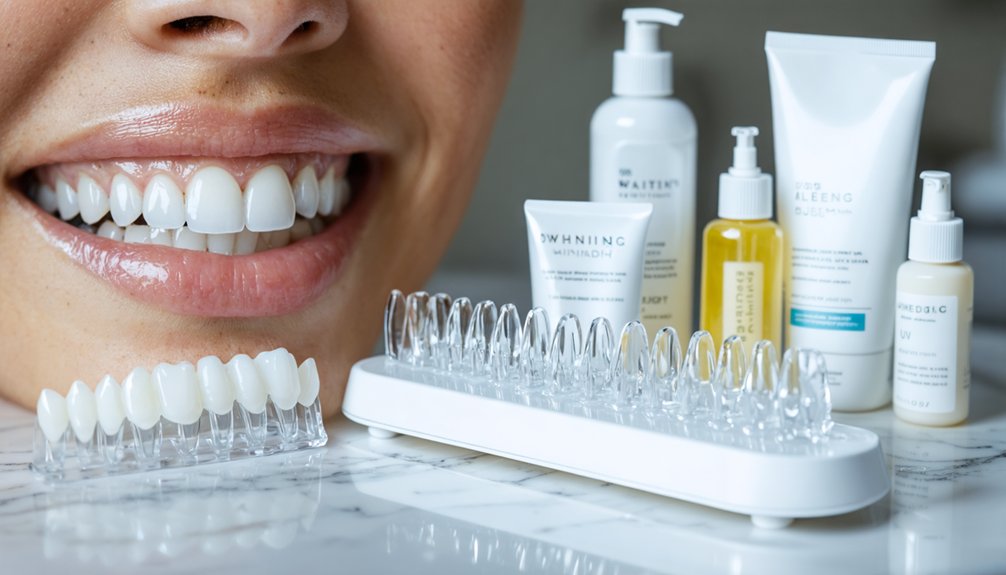
Your daily habits, including food choices and oral hygiene practices, play the most critical role in preserving your whitening results over time.
Professional follow-up care, scheduled every 6-12 months, helps monitor and maintain the brightness of your teeth through targeted touch-up treatments.
Making smart food choices, such as limiting staining beverages and using straws when consuming pigmented drinks, will greatly extend the longevity of your whitening treatment.
Daily Habits Matter Most
While professional teeth whitening treatments can deliver dramatic results, maintaining that bright smile depends heavily on your daily habits and lifestyle choices.
The most effective way to preserve your whitening results is through consistent oral hygiene and mindful dietary choices.
- Practice thorough daily brushing with whitening toothpaste and proper flossing techniques to remove stain-causing plaque and debris.
- Use a straw when consuming pigmented beverages like coffee, tea, or wine to minimize direct contact with teeth.
- Rinse your mouth with water immediately after consuming staining foods or drinks to wash away color agents.
- Incorporate crunchy fruits and vegetables into your diet, as their natural abrasive textures help remove surface stains.
Remember to maintain regular dental checkups every six months for professional cleaning and monitoring of your whitening results.
Professional Follow-up Care
Beyond daily habits, professional follow-up care plays a central role in preserving teeth whitening results. Your personalized care plan should include regular dental check-ups for professional cleanings and monitoring of your whitening progress.
Schedule touch-up treatments as recommended by your dentist to maintain your desired tooth color.
Implement proven follow-up strategies by using non-abrasive toothpaste and specialized tools like waterpiks and tongue scrapers. These tools enhance oral cleanliness and extend whitening longevity.
You’ll need to avoid tobacco products completely, as they cause deep stains that compromise your results. For ideal maintenance, combine professional treatments with consistent home care routines.
Your dentist can create a customized whitening plan that addresses your specific needs while ensuring long-term success through systematic monitoring and adjustments.
Smart Food Choices
Making smart food choices plays a pivotal role in preserving teeth whitening results.
You’ll want to focus on nutrient rich foods that protect your enamel while avoiding items that can compromise your bright smile. Whitening superfoods like crunchy vegetables and calcium-rich dairy products actively support your oral health while maintaining those professional results.
- Prioritize white or light-colored foods such as chicken breast, white fish, cauliflower, and plain yogurt.
- Include natural teeth-cleansing foods like celery, carrots, and apples that act as gentle abrasives.
- Choose calcium-rich dairy products, especially aged cheeses, to strengthen enamel and prevent staining.
- Consume non-acidic fruits such as bananas and pears, while avoiding deeply pigmented berries and citrus.
Alternative Solutions When Whitening Fails
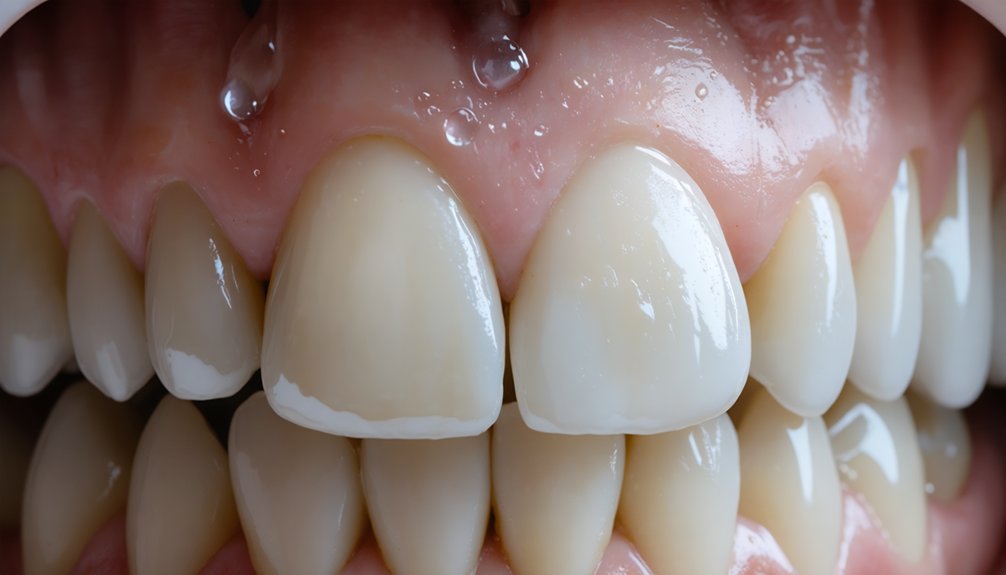
Since traditional whitening methods don’t work for everyone, understanding alternative treatment options becomes essential for addressing stubborn tooth discoloration.
Traditional whitening isn’t a one-size-fits-all solution – exploring alternative treatments is crucial for those struggling with persistent tooth discoloration.
When you experience persistent tooth sensitivity or whitening resistance, several restorative treatments can provide effective solutions.
Dental veneers offer a permanent solution by covering intrinsically stained teeth with custom-fitted porcelain shells.
For less severe cases, dental bonding applies tooth-colored resin to mask discoloration while preserving natural tooth structure.
Enamel microabrasion can effectively remove superficial stains through controlled surface treatment.
If you have intrinsic staining from trauma or medication, your dentist might recommend internal bleaching following root canal therapy.
When dealing with multiple restorations or severe enamel issues, combining treatments may be necessary to achieve uniform coloring across all teeth.
Preventing Future Discoloration
Your daily oral care habits form the foundation of stain prevention, including regular brushing, flossing, and using appropriate mouthwash.
When consuming beverages known to cause staining, you’ll minimize discoloration by using a straw, rinsing with water afterward, or adding milk to dark drinks like coffee and tea.
Maintaining a consistent schedule of professional dental cleanings every six months will remove accumulated stains and protect your enamel’s integrity through preventive treatments.
Daily Habits Matter Most
While professional whitening treatments can brighten your smile, daily habits determine how long those results will last.
Maintaining consistent hygiene practices and adopting protective measures in your daily routines will greatly extend the longevity of your whitening results.
- Brush twice daily with whitening toothpaste using a soft-bristled brush, and don’t forget to clean your tongue to reduce bacterial buildup.
- Stay hydrated and rinse with water after consuming pigmented foods or beverages to prevent stains from settling.
- Use xylitol gum to stimulate saliva production, which naturally cleanses teeth and protects against discoloration.
- Avoid brushing immediately after acidic foods; instead, rinse with water first to protect your enamel from damage when it’s temporarily softened.
Smart Beverage Choices
Understanding which beverages cause tooth discoloration is essential for maintaining a bright smile long-term.
You’ll find that dark-colored drinks containing tannins and chromogens, like red wine, coffee, and black tea, pose the highest staining risk. These compounds bind to your enamel, especially when combined with acidic ingredients that erode tooth surfaces.
For effective staining prevention, opt for beverage alternatives with lower pigment content, such as herbal teas, white wine, or plain water.
When you do consume staining drinks, use a straw to minimize tooth contact, and rinse your mouth immediately afterward. Adding milk to tea can help neutralize tannins, while choosing unsweetened versions reduces acid exposure.
Professional Maintenance Schedule
Beyond making smart beverage choices, maintaining white teeth requires a structured professional care schedule. Your whitening frequency and maintenance products should align with professional guidance to guarantee ideal results while protecting your enamel health.
Follow these essential professional maintenance steps:
- Schedule dental cleanings every six months for thorough plaque and tartar removal, including professional polishing to reduce stain adherence.
- Undergo dental assessments post-whitening to monitor enamel wear and determine touch-up timing.
- Plan whitening touch-ups every 6-12 months using dentist-prescribed products rather than over-the-counter alternatives.
- Use desensitizing toothpaste during initial weeks post-treatment when enamel is most permeable, and avoid harsh whitening products that could compromise results.
Choosing the Right Treatment Path
Selecting an effective teeth whitening treatment depends primarily on the type and severity of your discoloration. Through professional stain assessment, your dentist can determine whether you’re dealing with extrinsic surface stains or more challenging intrinsic discoloration, which guides treatment selection.
For surface stains, LED-activated or laser treatments combined with professional-grade peroxide gels often deliver dramatic results in a single session.
However, if you’re dealing with intrinsic stains from medication or trauma, you’ll need more intensive options like KöR whitening or extended professional tray systems.
Treatment customization is essential – your dentist can adjust parameters such as gel concentration and light intensity based on your sensitivity levels and desired outcomes.
For ideal results with stubborn stains, combination approaches using both in-office and take-home treatments may be recommended.
Cost-Effective Approaches to Teeth Whitening
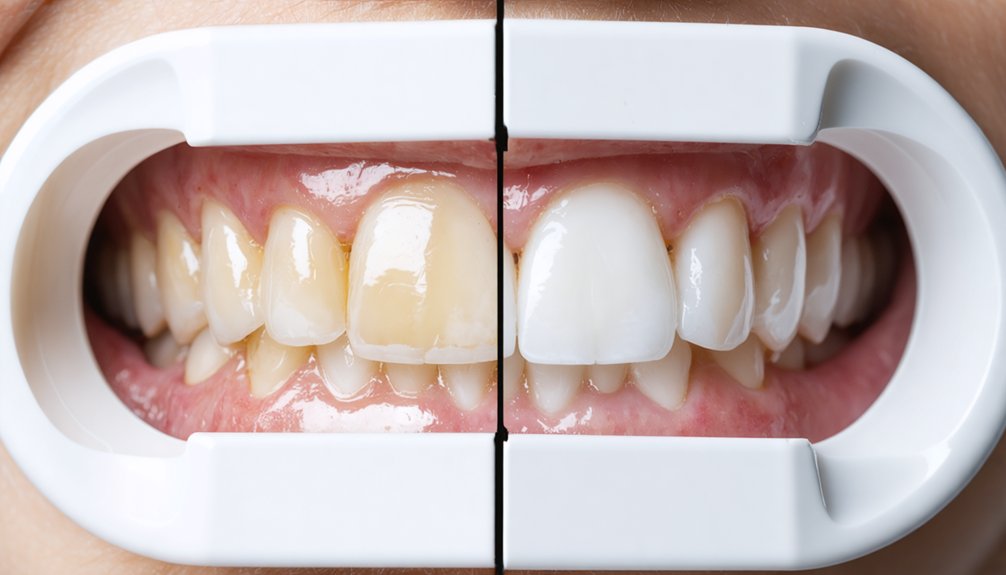
While professional teeth whitening treatments deliver impressive results, numerous cost-effective alternatives can help you achieve a brighter smile without breaking the bank.
When evaluating options, it’s crucial to separate proven methods from whitening myths and focus on evidence-based approaches.
- Over-the-counter strips ($11-45) offer significant results at a fraction of professional costs, with products like Crest 3D White Whitestrips showing consistent effectiveness.
- Whitening toothpastes and rinses (under $10) help maintain results and remove surface stains.
- Natural remedies like baking soda can safely polish away mild stains when used occasionally, though results are less dramatic.
- At-home whitening kits ($10-50) provide a middle-ground option, with trays and strips offering better results than pens due to extended contact time.
Frequently Asked Questions
Can Medications I’m Currently Taking Affect the Success of Teeth Whitening Treatments?
Like a rusty sword dulls with age, your medication types can greatly impact whitening effectiveness. You’ll need professional guidance, as certain antibiotics and antihypertensives affect both staining patterns and treatment outcomes.
How Soon After Whitening Can I Safely Get Dental Work Done?
You’ll need to wait at least two weeks after whitening before proceeding with dental procedures. This whitening timeline guarantees stable tooth color and allows sensitivity to subside for best restoration results.
Is Professional Teeth Whitening Safe During Pregnancy or While Breastfeeding?
You shouldn’t undergo professional teeth whitening during pregnancy or breastfeeding due to safety concerns. While no direct harm’s proven, healthcare providers recommend waiting to avoid potential risks to your baby.
Will Whitening Treatments Affect the Strength of My Tooth Enamel?
You’ll experience minimal, reversible effects on enamel strength when using whitening treatments properly. Professional supervision guarantees ideal whitening effectiveness while protecting your teeth’s structural integrity through controlled application methods.
Can Repeated Professional Whitening Treatments Cause Long-Term Damage to My Teeth?
Persistently pursuing professional whitening can cause permanent problems. If you’re experiencing teeth sensitivity, reduce whitening frequency. Excessive treatments may weaken enamel, increasing risk of long-term damage and discomfort.
References
- https://renewdentaltn.com/post/stubborn-tooth-stains-heres-what-you-can-do-about-them
- https://www.knoxvillesmilecenter.com/blog/say-goodbye-to-stains-effective-teeth-whitening-solutions/
- https://www.omdentalstudio.com/teeth-whitening/
- https://www.drbobsdentalcare.com/will-teeth-whitening-remove-stains/
- https://myashburndentist.com/stained-to-sparkling-how-professional-whitening-outshines-diy-methods/
- https://www.dentalartsofplymouth.com/the-ultimate-guide-to-achieving-dazzling-teeth-with-professional-teeth-whitening-methods-and-diy-techniques/
- https://www.fletcherfamilydentistry.com/laser-teeth-whitening-vs-other-methods/
- https://www.colgate.com/en-sa/oral-health/teeth-whitening/dental-office-whitening-treatments-in-just-one-visit
- https://www.gvdentalcenter.com/services/teeth-whitening/tooth-whitening-process/
- https://www.alliedacademies.org/articles/classification-of-tooth-staining.pdf
